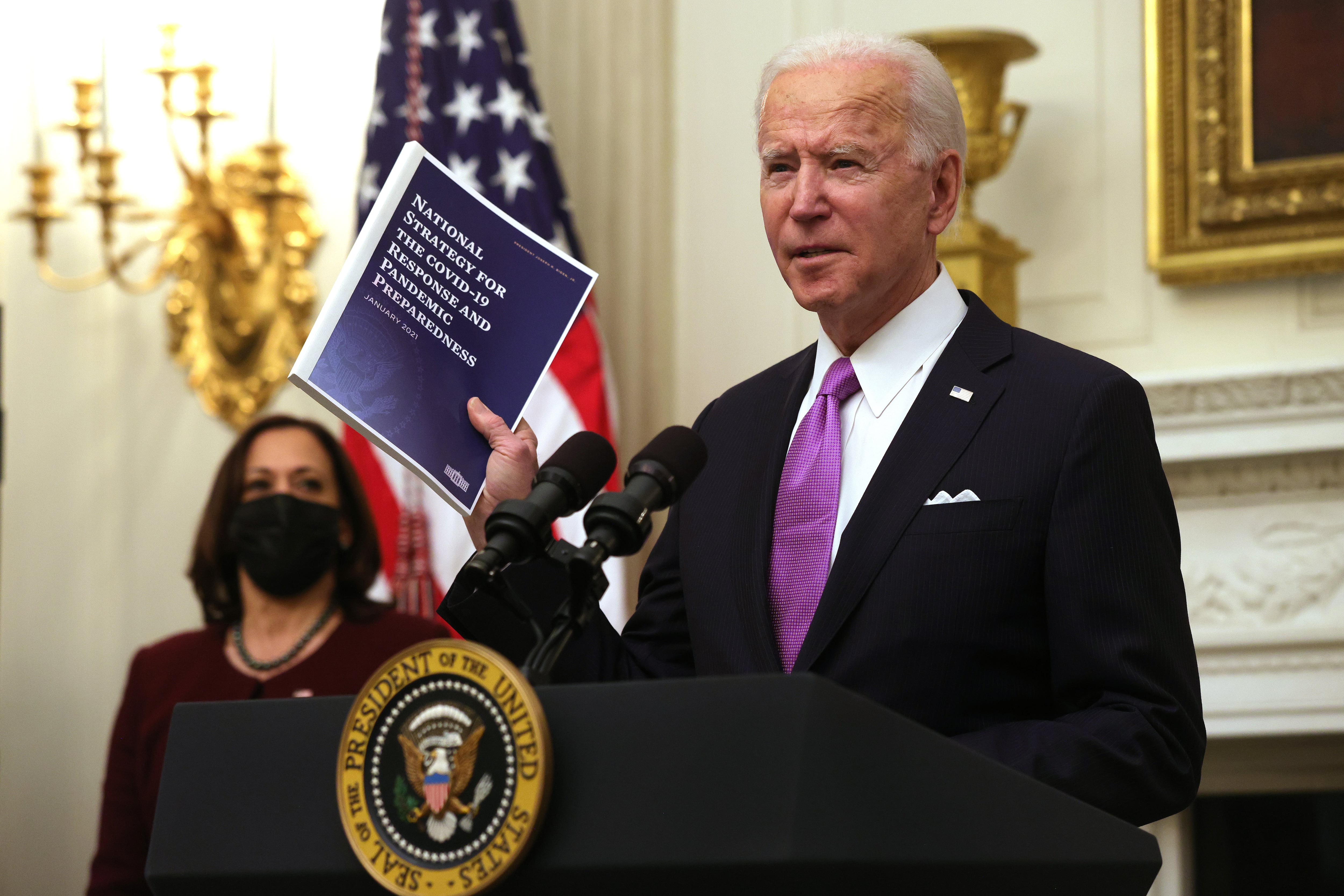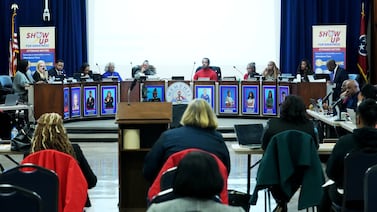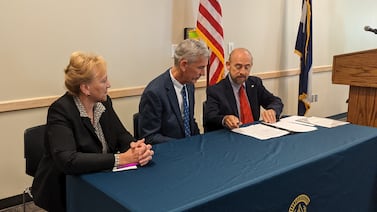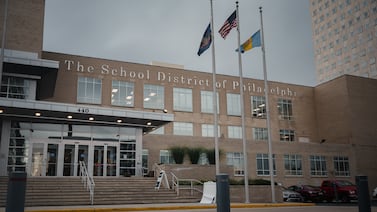On his first full day in office, President Joe Biden said his administration would do everything it could to help schools reopen their buildings in the coming months.
The new administration released a detailed national COVID response plan Thursday that includes creating a clearinghouse of best practices for schools, tracking school openings, ratcheting up virus testing and vaccinations, and pushing for tens of billions in additional aid for schools.
“Today, we’re directing the Department of Education and the Department of Health and Human Services to immediately provide schools and communities with clear guidance and resources,” Biden said before signing a flurry of executive orders, including one focused on school reopening. “I know these bold and practical steps will not come cheaply, but failing to do so will cost us so much more dearly.”
School leaders like Susan Enfield, the superintendent of Highline Public Schools in suburban Seattle, which isn’t set to welcome a significant number of students back into buildings until March, cheered the idea of a national reopening strategy.
“We need consistent information across the states,” she said. “We have to rebuild confidence on the part of our teachers and staff that this can be done safely. Because that confidence is nonexistent right now.”
Still, it’s not clear how much the schools-focused executive order, which is focused on recommendations rather than mandates, will affect local decisions about whether and when to open buildings. More likely to be influential are the administration’s broader efforts to contain the virus’s spread and get Americans vaccinated as quickly as possible.
Biden’s most specific goal — for a majority of K-8 schools to be open within 100 days — has likely already been met. Current estimates suggest that about half of American schoolchildren have access to at least some in-person instruction. But the number who are actually learning in school buildings is substantially lower, since many families have opted for fully remote schooling. Black, Hispanic, and low-income children are particularly likely to be learning virtually.
The consequences of this are far-reaching: students have already lost learning in math, and more students are failing classes this year, especially students who struggled academically even before the pandemic. School closures have also affected the economy, making it harder for parents, particularly mothers, to work.
When schools are fully open again, “Think of all the people who can get back to work,” said Biden.
But the continued prevalence of the coronavirus has made that a challenge. Many families and teachers are resistant to returning, and some schools have been too short-staffed to stay open for in-person learning. Recent research has suggested that the degree to which open schools further the spread of COVID turns on pre-existing rates of spread in the community. COVID rates among teachers have increased sharply in recent months, though the reason isn’t entirely clear.
The good news is that there is now a vaccine, and in many states, teachers and other school staff are being prioritized. Biden wants to quickly ramp up production of the vaccine and make more tests available to schools so they can quickly detect the virus.
“The United States will spare no effort to ensure Americans can get vaccinated quickly, effectively, and equitably,” the administration’s plan says.
That’s welcome news to school leaders like Erik Edoff, the superintendent of L’Anse Creuse Public Schools, which serves just over 10,000 students in the suburbs of Detroit. While schools there are offering in-person instruction, he sees vaccine distribution as crucial to getting more students to return.
His district began the school year with about 70% of students back in person, and that share has only risen slightly since. The rest are still remote, often because they are living with older or immunocompromised relatives.
“As a district, we’ve done a good job doing everything we can do to make it as safe as possible for face-to-face learning,” he said. It’s going to take more vaccines and fewer cases “to make the remainder of the families feel comfortable.”
The vaccine rollout will take time, though, and some teachers unions say they need additional safety measures. The National Education Association, the country’s largest teachers union and a Biden ally, praised his plan but also hinted that it might not be enough.
“President Biden’s plan provides great reason for sorely-needed optimism, but we cannot forget that, right now, the reality in far too many schools and institutions of higher education is that effective distancing, mask-wearing, ventilation, COVID-19 testing, contact tracing, and other crucial mitigation strategies are not in place,” NEA President Becky Pringle said in a statement.
Biden also directed the Centers for Disease Control and Prevention and the education and health departments to update their guidance on reopening schools, and to continue to do so based on the latest science.
Susan Hassig, a Tulane University epidemiologist who has studied school reopening, says the CDC should be clearer about what mitigation measures are necessary. “I would like to see them be more explicitly directive and say, ‘You shouldn’t open schools unless you can do this,’” she said.
Under President Trump, school leaders sometimes criticized CDC guidance as unhelpful or untrustworthy, especially after White House officials pressured the CDC to downplay the risks of reopening schools last summer.
“We’re going to make sure [scientists] work free from political interference and they make decisions strictly based on science and health care alone,” said Biden. “Vice President Harris and I and our entire administration will always be honest and transparent with you about both the good news and the bad.”
The education and health departments also will be asked to collect information to inform state and local officials’ decisions about opening and closing schools, including data about how school closures have affected students of color, students from low-income families, English learners, and students with disabilities.
Former Education Secretary Betsy DeVos had said it was not the job of the federal government to track school districts’ reopening plans or their infection rates.
Edoff, the Michigan superintendent, is hoping for standardized metrics that would help school districts decide whether to stay open, shrink class sizes, or go remote after a school year in which those decisions were made “looking at the data however you want.”
Biden has also proposed a massive infusion of additional money for schools: $130 billion, which amounts to $2,600 per public school student. That money, which would require Congress to act, could help schools safely reopen and offer extra help to students who have fallen behind.
But some officials say money isn’t what’s holding them back. In Washington, Enfield said that the biggest obstacles to reopening have been changing state rules, a lack of clear federal guidance, and fear among staff and families.
“Money is an issue, but I wouldn’t say that it’s the biggest issue,” she said. Right now, her district has a sufficient stockpile of personal protective equipment, cleaning supplies, and money to hire extra custodians from the stimulus package that was passed last March. “The biggest deterrent is fear, and that fear comes from either a lack of information or conflicting information, both of which have been a significant challenge for us to deal with in recent months.”





